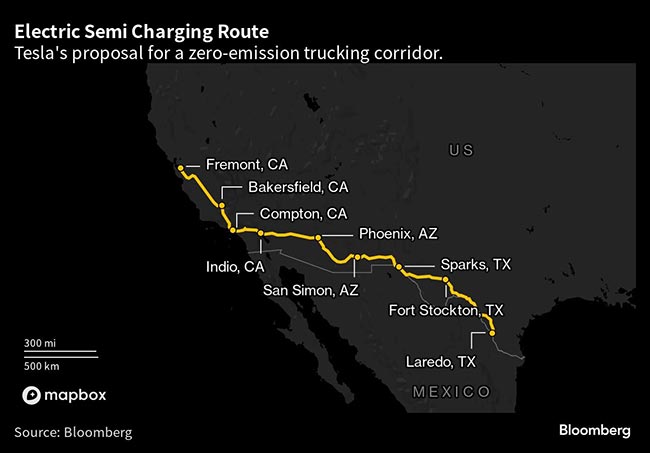Tesla Inc. is requesting around $100 million from the U.S. government to establish nine charging stations for electric semi-trucks. These stations are planned to be built along a route that stretches from the southern border of Texas to northern California, as revealed in emails obtained by Bloomberg News.
In their correspondence with the Texas Department of Transportation between May and early July, Tesla executives proposed equipping each station with eight 750-kilowatt chargers for their Tesla Semi vehicles, along with four chargers for trucks manufactured by competing companies. This initiative aims to create a unique charging network in the United States, facilitating long-distance electric trucking from Texas to California, as well as regional-haul trucking within Texas, Arizona, and California. This move is significant since commercial trucks are essential for transporting goods in the U.S., but the sector’s greenhouse gas emissions have been a challenge to control.
Tesla’s executives informed Texas officials that the proposed corridor could potentially be eligible for federal grants, part of a new bipartisan infrastructure program aimed at modernizing the country’s transit systems and addressing various infrastructure needs. To support their funding application submitted in June, Tesla asked the state officials to provide a letter endorsing the big rig-charging project.

The Federal Highway Administration, responsible for overseeing grants, is currently evaluating applications, and it plans to announce the recipients later this year.
The application for the charging network project was led by California’s South Coast Air Quality Management District on behalf of Tesla, headquartered in Austin. Tesla is seeking $97 million in federal funding and intends to contribute $24 million from its own funds.
Whether Tesla would proceed with the project without a grant remains uncertain, as the company has not responded to inquiries for comment.
The proposed route spans approximately 1,800 miles, starting in Laredo, Texas, which is about 240 miles away from Tesla’s Austin headquarters and 150 miles from its newly constructed factory in Nuevo Leon, Mexico.
Tesla already has a presence at that border crossing. In 2022, the company was granted an exclusive lane to transport parts from suppliers in Mexico to its U.S. factories, a route currently dominated by combustion-engine vehicles.
Tesla unveiled a prototype of its electric Semi truck in 2017, but has faced challenges in bringing it to the market. While it managed to deliver 15 trucks to PepsiCo Inc. in late 2022, some of those initial vehicles experienced breakdowns, leading to a recall in March.
According to regulatory filings, Tesla still refers to the Semi as being in “pilot production.”
During an energy conference in Austin in June, CEO Elon Musk indicated that the Tesla Semi is not expected to be produced in significant quantities until the following year. He attributed part of the delay to difficulties encountered by both Tesla and its partner Panasonic Holdings Corp. in manufacturing batteries that can provide the truck’s advertised 500-mile range.





